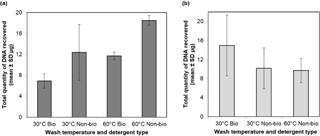Persistence of DNA from laundered semen stains: Implications for child sex trafficking cases |
| |
| Affiliation: | 1. UCL Centre for the Forensic Sciences, 35 Tavistock Square, London WC1H 9EZ, UK;2. UCL Department of Security and Crime Science, 35 Tavistock Square, London WC1H 9EZ, UK;3. Faculty of Life Sciences and Medicine, KCL, Franklin-Wilkins Building, London SE1 9NH, UK |
| |
| Abstract: | 
In sexual assault cases, particularly those involving internal child sex trafficking (ICST), victims often hide their semen-stained clothing. This can result in a lag time of several months before the items are laundered and subsequently seized during a criminal investigation. Although it has been demonstrated previously that DNA can be recovered from clothing washed immediately after semen deposition, laundered items of clothing are not routinely examined in ICST cases, due to the assumption that the time delay and washing would result in no detectable DNA. The aim of this study was to examine whether viable DNA profiles could be recovered from laundered semen stains where there has been a significant lag time between semen deposition from one or more individuals and one or more washes of the stained clothing.Items of UK school uniform (T-shirts, trousers, tights) were stained with fresh semen (either from a single donor or a 1:1 mixture from two donors) and stored in a wardrobe for eight months. Stained and unstained items (socks) were then washed at 30 °C or 60 °C and with non-biological or biological detergent. DNA samples extracted from the semen-stained sites and from the unstained socks were quantified and profiled.High quantities of DNA, (6–18 μg) matching the DNA profiles of the semen donors, were recovered from all semen-stained clothing that had been laundered once, irrespective of wash conditions. This quantity,and profile quality,did not decline significantly with multiple washes. The two donor semen samples yielded ∼10-fold more DNA from the T-shirts than from the trousers. This disparity resulted in the T-shirts yielding a ∼1:1 mixture of DNA from the two donors, whereas the trousers yielded a major DNA profile matching only that of the second donor. The quantities of DNA recovered from the unstained socks were an order of magnitude lower, with most of the DNA being attributable to the donor of the semen on the stained clothing within the same wash, demonstrating the transfer of semen-derived DNA among items of clothing in the washing machine.This study demonstrates that complete DNA profiles can be obtained from laundered semen stains on school uniform-type clothing, with an eight-month lag time between semen deposition and laundering, despite multiple washes and stains from two semen donors. These data emphasise the need to recover and examine the clothing of victims for semen and DNA evidence, even if the clothing has been stored for several months or washed multiple times since the sexual offence took place. |
| |
| Keywords: | Child sexual exploitation Internal child sex trafficking Forensic science Spermatozoa DNA Persistence Transfer |
| 本文献已被 ScienceDirect 等数据库收录! |
|

